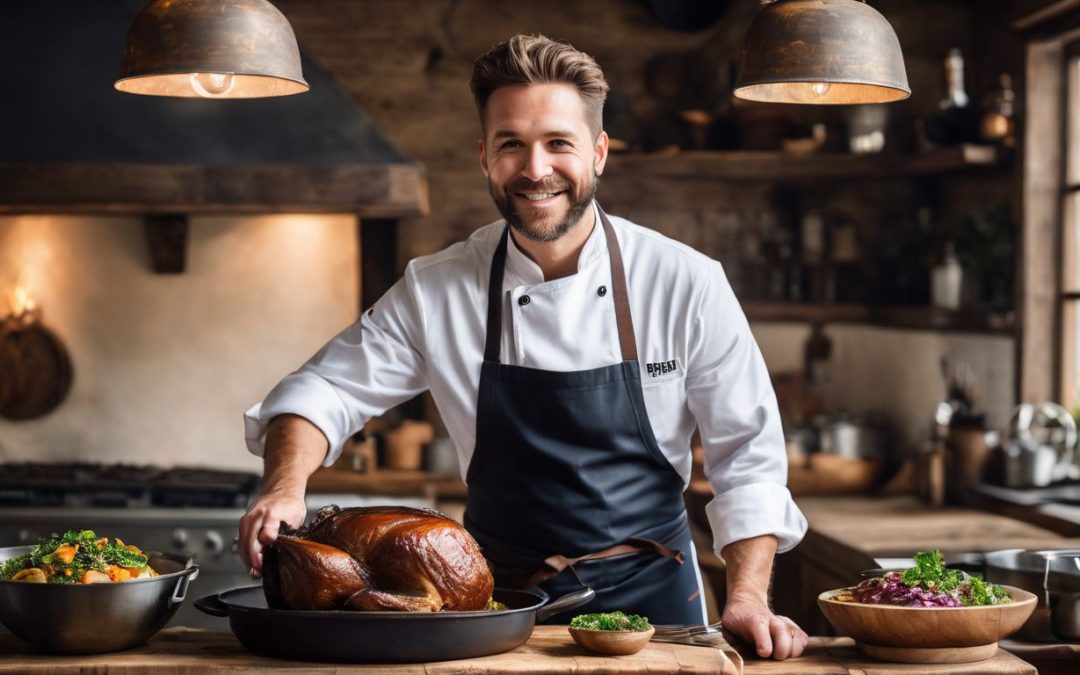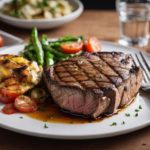If the thought of cooking a pot roast intimidates you, you’re not alone. Many home cooks struggle to achieve that tender and juicy result every time. Our article will guide you through choosing the right cut, properly seasoning it, and selecting the perfect cooking method for your pot roast.
Ready to master this classic comfort dish? Let’s get started!
Choosing the Right Cut of Meat for Pot Roast
When it comes to pot roast, picking the perfect cut of meat is crucial. Understanding the different cuts and factors to consider will ensure a melt-in-your-mouth experience every time you cook up this classic dish.
Understanding the different cuts
There are many cuts of meat to pick from for your pot roast.
- Chuck Roast: It’s a top pick because it becomes very tender after long cooking. This cut comes from the shoulder of the cow.
- Eye of Round Roasts: Another choice for pot roasts. This cut is lean and comes from the rear part of the cow.
- Brisket: This cut comes from the chest of the cow, so it has a lot of connective tissue. It gets super tender when slow-cooked over hours.
- Bottom or Top Round Roasts: These cuts come from the back leg area of the cow and are leaner than others.
Best cuts for pot roast
When it comes to the perfect pot roast, the cut of meat you choose plays a big role. There are different cuts suitable for pot roast, but some of them truly stand out. Here’s a quick guide to the best cuts for a savory, melt-in-your-mouth pot roast.
| Cut of Meat | Why It’s Good for Pot Roast |
| Chuck Roast | The chuck roast is a top choice for pot roast. It’s an affordable cut with enough fat and connective tissue that breaks down during slow cooking, resulting in a deliciously tender pot roast. |
| Eye of Round Roast | Eye of Round Roast, while leaner than the chuck roast, can also yield a tasty pot roast. This cut requires careful cooking to avoid toughness, but when done right, provides a leaner option for pot roast lovers. |
| Bottom Round Roast | Similar to the eye of round, the bottom round can also be used for pot roast. It’s a lean cut derived from the rear muscle of the cow, making it a little tougher. However, when slow-cooked, it can still yield a tender, flavorful meal. |
| Brisket | Brisket is a cut from the breast section of the animal and is known for its rich flavor. This cut is typically used for barbecue and smoking but can also be used for pot roast. It requires slow cooking to break down the connective tissues, resulting in a tender and flavorful pot roast. |
Remember, the secret to a perfect pot roast doesn’t just lie in the cut of meat, but also how it’s seasoned, seared, and slow-cooked to perfection. Enjoy the process and most importantly, enjoy the meal!
Factors to consider when choosing meat
When choosing meat for your pot roast, there are a few factors to consider that will help you achieve the perfect result. First, think about the cut of meat you want to use. Chuck roast is a popular choice because it’s flavorful and becomes tender when cooked slowly.
Eye of Round Roasts or other round roasts can also work well. Consider the marbling in the meat too – more marbling means more flavor and tenderness. Additionally, look for meat that is bright red with minimal discoloration or browning.
Another important factor is the size of the roast. Smaller cuts are great for quicker cooking methods like pressure cookers or Instant Pots, while larger cuts may be better suited for slow cooking in an oven or crockpot.
Lastly, think about your budget and what works best for you. Pot roasts can be made with different cuts of beef at various price points, so choose one that fits within your budget while still providing good quality.
Preparing the Pot Roast
Season the meat with your favorite seasonings, like salt, pepper, garlic powder, and paprika to give it a burst of flavor.
Seasoning the meat
Seasoning the meat is an important step in cooking the perfect pot roast. Here’s how to do it:
- Start by seasoning the roast with kosher salt and black pepper.
- Rub the seasonings all over the meat, making sure to cover all sides.
- For added flavor, you can also add herbs and spices like garlic powder, onion powder, or rosemary.
- Don’t be afraid to be generous with the seasoning – it will enhance the taste of the meat.
- Let the seasoned roast sit at room temperature for about 30 minutes before cooking.
Searing the meat
To achieve a delicious pot roast, it’s important to sear the meat before cooking. Searing helps to lock in the flavors and create a savory crust on the outside of the meat. Here are the steps for searing the meat:
- Heat a large skillet or Dutch oven over medium – high heat.
- Add a splash of olive oil to the pan and let it heat up.
- Season your pot roast with kosher salt and pepper, ensuring all sides are coated.
- Carefully place the roast in the hot pan and let it sizzle for about 2 – 3 minutes on each side until nicely browned.
- Use tongs or a spatula to flip the roast and sear all sides evenly.
- Once seared, transfer the meat to a plate or cutting board and set aside.
Adding aromatics and vegetables
To make your pot roast delicious, add aromatics and vegetables. Here’s how:
- Use onions, garlic, and herbs like thyme and rosemary for flavor.
- Add carrots, celery, and potatoes for a complete meal.
- The aromatics and vegetables will enhance the taste of the meat.
- They will also add nutrients and make your pot roast more satisfying.
Cooking Methods for Pot Roast
Slow cooking in the oven, using a slow cooker/Crock-Pot, or trying out the Instant Pot/pressure cooker method are all fantastic ways to achieve mouthwateringly tender pot roast. Read on to discover which method will suit your cooking style and time constraints.
Slow cooking in the oven
Slow cooking in the oven is a great way to make a perfect pot roast. Here are some steps to follow:
- Preheat your oven to a low temperature, around 275-300°F (135-150°C).
- Season your pot roast with salt and pepper or any other desired seasonings.
- Heat a large oven-safe pot or Dutch oven on the stove over medium-high heat.
- Add some oil and sear the meat on all sides until browned.
- Remove the meat from the pot and set it aside.
- Add onions, garlic, carrots, and celery to the pot and cook until they start to soften.
- Put the meat back into the pot with the vegetables.
- Pour in beef stock or broth until it covers about half of the meat.
- Cover the pot with a tight – fitting lid and place it in the preheated oven.
- Let it cook slowly for about 3 – 4 hours, or until the meat is tender and can easily be pulled apart with a fork.
Using a slow cooker/Crock-Pot
If you have a slow cooker or Crock-Pot, you can easily make a delicious pot roast. Here’s how:
- Place the seasoned meat in the slow cooker.
- Add onions and other aromatics like garlic or herbs.
- Pour in beef stock to cover the meat.
- Cook on low for 8-10 hours or on high for 4-6 hours.
- The slow cooker will keep the meat moist and tender.
Instant Pot/pressure cooker method
Want to cook a tender and juicy pot roast in no time? The dutch oven pot or pressure cooker method is perfect for you! Here’s how to do it:
- Choose a chuck roast or another suitable cut of beef for your pot roast.
- Season the meat with kosher salt and pepper.
- Heat some olive oil in the Instant Pot on the sauté mode.
- Sear the seasoned meat on all sides until browned.
- Remove the meat from the pot and set it aside.
- Add chopped onions, garlic, and any other desired aromatics to the pot.
- Sauté them until softened and fragrant.
- Place the seared meat back into the Instant Pot on top of the onions.
- Pour in beef stock or broth to cover about half of the meat.
- Lock the lid of the Instant Pot and set it to pressure cook for about 60 – 90 minutes, depending on the size of your roast.
- Allow natural pressure release for at least 10 minutes before quick releasing any remaining pressure.
- Carefully remove the lid once all pressure has been released.
- Take out the cooked pot roast and let it rest before slicing.
Tips for a Perfectly Tender Pot Roast
Cook the pot roast at a low temperature for a longer time to ensure tender meat that falls apart with each bite.
Cooking time and temperature
To cook the perfect pot roast, it’s important to get the cooking time and temperature right. For a tender and juicy pot roast, you’ll want to cook it low and slow. Set your oven or slow cooker to around 275-300°F (135-150°C) for about 3-4 hours.
This slow cooking method helps break down the tough fibers in the meat and makes it more tender. If you’re using an Instant Pot or pressure cooker, cook on high pressure for around 60 minutes.
Remember to let the meat rest before slicing so that it retains its juices. By following these cooking tips, you’ll be able to enjoy a moist and delicious pot roast every time!
Resting the meat before slicing
After cooking your pot roast to perfection, it’s important to let the meat rest before slicing. This allows the juices to redistribute and settle, resulting in a tender and flavorful roast.
Simply remove the pot roast from the heat source and cover it loosely with foil. Let it rest for about 10-15 minutes before slicing into it. During this time, you can prepare your side dishes or make a delicious sauce to serve with the meat.
When you slice into that perfectly cooked pot roast, you’ll be rewarded with juicy and succulent bites of meat that will have everyone coming back for seconds!
Skimming fat from the cooking liquid
After cooking your pot roast, it’s important to skim off any excess fat from the cooking liquid. This helps to remove any greasy or oily taste and allows the flavors of your ingredients to shine through.
To do this, let the cooking liquid cool slightly so that the fat rises to the top. Then, use a spoon or ladle to carefully scoop off the layer of fat that has formed on the surface.
You can also use a gravy separator or a fat separator pitcher for easier and more efficient skimming. By removing the excess fat, you’ll be left with a delicious and flavorful pot roast that is perfect for serving.
Serving and Enjoying the Perfect Pot Roast
Slice the tender, juicy meat into thick slices and serve it up with a side of creamy mashed potatoes and roasted carrots for a hearty and satisfying meal. Don’t forget to drizzle some of the rich cooking liquid over the top for extra flavor! And if you have any leftovers (which is unlikely), they make for incredible sandwiches or can be transformed into delicious beef stew.
Slicing and serving the meat
To enjoy your perfectly cooked pot roast, here’s how to slice and serve it:
- Let the meat rest for about 10 – 15 minutes before slicing. This allows the juices to redistribute and makes for a more tender roast.
- Use a sharp carving knife or chef’s knife to slice the meat against the grain. This helps ensure each bite is tender and easy to chew.
- Aim for slices that are about ½ inch thick. Thicker slices can be harder to eat, while thinner ones may dry out quickly.
- Arrange the slices on a platter or individual plates, drizzling any remaining cooking liquid over the top for added flavor.
- Serve your pot roast with your choice of side dishes like roasted vegetables, mashed potatoes, or buttered noodles.
- If desired, you can make a sauce using the cooking liquid by simmering it in a pan until it reduces slightly and thickens.
- Garnish with fresh herbs like parsley or rosemary to add color and freshness.
Pairing with side dishes and sauces
- Serve your perfect pot roast with creamy mashed potatoes for a classic and comforting combination.
- Roasted root vegetables, such as carrots, parsnips, and potatoes, complement the savory flavors of pot roast.
- Don’t forget to serve some steamed or roasted green beans or broccoli for a healthy and colorful side.
- For a Southern twist, pair your pot roast with buttery cornbread or fluffy biscuits.
- A tangy horseradish sauce adds a delicious kick to your tender pot roast.
- If you prefer a richer flavor, try serving your pot roast with a red wine reduction or mushroom gravy.
- A dollop of tangy mustard or horseradish can enhance the flavors of your pot roast even more.
- If you’re looking for something refreshing, serve your pot roast with a crisp salad dressed in vinaigrette.
- Warm crusty bread is always a great choice to soak up the flavorful juices from the pot roast.
- And of course, don’t forget to enjoy it with your favorite glass of red wine or ice – cold beer.
Storing and reheating leftovers
Leftovers are just as delicious as the fresh pot roast, so it’s important to store them properly. Here’s how to store and reheat your leftover pot roast:
- Let the pot roast cool down before storing it in an airtight container or wrap it tightly with aluminum foil.
- Store the leftovers in the refrigerator for up to 3 – 4 days.
- If you want to freeze the leftovers, place them in a freezer – safe container or freezer bags and store them for up to 3 months.
- When reheating, you can use either the stovetop or microwave.
- To reheat on the stovetop, place the leftover pot roast in a skillet with some beef broth or gravy over medium heat until heated through.
- If using a microwave, transfer the pot roast and any juices into a microwave-safe dish, cover loosely, and heat on high for 1-2 minutes at a time until warmed up.
- Stir occasionally to ensure even heating.
- Remember not to overheat as it can dry out the meat.
Conclusion
Now you know how to cook the perfect pot roast! Whether you choose a chuck roast or another cut, seasoning it well and searing it before cooking will give you juicy and tender meat.
You can slow cook it in the oven, use a slow cooker or pressure cooker for convenience. Remember to let the meat rest before slicing and skim any fat from the cooking liquid for a delicious meal.
Enjoy your perfectly cooked pot roast with your favorite sides and sauces!
FAQs
1. What is the best way to cook a perfect pot roast?
The ultimate guide to cooking the perfect pot roast suggests using different methods like slow cooker, dutch oven or instant pot for juicy and tender meat.
2. How can I make my pot roast more tender?
You can use tips such as braising a chuck roast in beef stock, trying low effort dinner techniques or picking popular cuts of beef based on our guide for tenderizing pot roast.
3. Can I find variations of the pot roast recipe?
Yes! The ultimate guide offers many ways like pressure cooker and oven baked methods along with various seasonings and spices to add flavor to your roast.
4. How long should I cook a pot roast?
Cooking times and temperatures may vary depending on method used but you’ll find detailed instructions in our “Ultimate Guide to Cooking the Perfect Pot Roast”.
5. Are there suggested side dishes for my pot roast?
Our guide includes ideas for side dishes that go well with beef pot roasts, giving you options beyond traditional accompaniments.
Greetings!
With over two decades of diverse experience in the meat industry, I proudly stand as an expert in all things meat. My journey commenced with a strong foundation in hospitality, where I honed my culinary skills as a chef in prestigious restaurants and on luxurious superyachts worldwide.
However, my true passion lies in the art of butchery. Throughout my extensive career, I have had the privilege of working with renowned meat purveyors and mastering the craft of meat cutting and preparation. From breaking down whole carcasses to meticulously selecting prime cuts, my butchery expertise is at the core of my meat knowledge.
Having immersed myself in various cultures and cuisines, I have honed my skills to deliver exceptional dining experiences, crafting delectable dishes that celebrate the natural flavors of different meats. Whether it’s sourcing the finest meats for discerning clients or sharing valuable tips on meat selection and cooking, I take pride in elevating the meat experience for both professionals and enthusiasts.
My journey has taken me from the bustling kitchens of top-rated restaurants to the heart of meat processing facilities, gaining insights and honing my skills to become a true meat connoisseur. Now, I am enthusiastic about sharing my expertise, offering valuable insights on meat selection, cooking techniques, and the art of butchery.
















